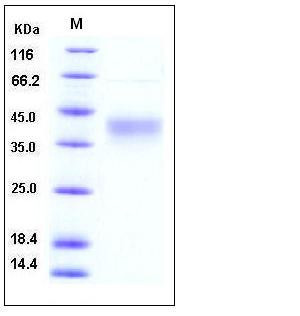Human CD48 / SLAMF2 / BCM1 Protein (His Tag)
BCM1,BLAST,Blast-1,BLAST1,hCD48,mCD48,MEM-102,SLAMF2
- 100ug (NPP1175) Please inquiry
| Catalog Number | P10797-H08H |
|---|---|
| Organism Species | Human |
| Host | Human Cells |
| Synonyms | BCM1,BLAST,Blast-1,BLAST1,hCD48,mCD48,MEM-102,SLAMF2 |
| Molecular Weight | The secreted recombinant human CD48 comprises 205 amino acids with a predicted molecular mass of 23.8 kDa. As a result of glycosylation, rhCD48 migrates as an approximately 40 kDa band in SDS-PAGE under reducing conditions. |
| predicted N | Gln 27 |
| SDS-PAGE |  |
| Purity | > 95 % as determined by SDS-PAGE |
| Protein Construction | A DNA sequence encoding the human CD48 (NP_001769.2) (Met 1-Ser 220) with a C-terminal polyhistidine tag was expressed. |
| Bio-activity | Measured by its binding ability in a functional ELISA . Immobilized human CD48 at 10 μg/ml (100 μl/well) can bind recombinant human 2B4 / CD244 with a linear range of 0.004-0.4 μg/ml. |
| Research Area | Immunology |Cluster of Differentiation (CD) |Monocyte/Macrophage CD Antigen |Other Monocytes/Macrophages CD Antigen |
| Formulation | Lyophilized from sterile PBS, pH 7.4 1. Normally 5 % - 8 % trehalose and mannitol are added as protectants before lyophilization. Specific concentrations are included in the hardcopy of COA. |
| Background | Cluster of Differentiation 48 (CD48), also known as SLAMF2, BCM-1 and BLAST-1, is a GPI-linked protein belonging to the CD2 subfamily of immunoglobulin superfamily molecules. CD2 and 2B4 (CD244) are known ligands for CD48. CD48 protein is expressed on most lineage-committed hematopoietic cells but not on hematopoietic stem cells or multipotent hematopoietic progenitors. CD48 protein performs biological functions in a variety processes including adhesion, pathogen recognition, cellular activation, and cytokine regulation, and emerges as a critical effector molecule in immune responses. |
| Reference |
